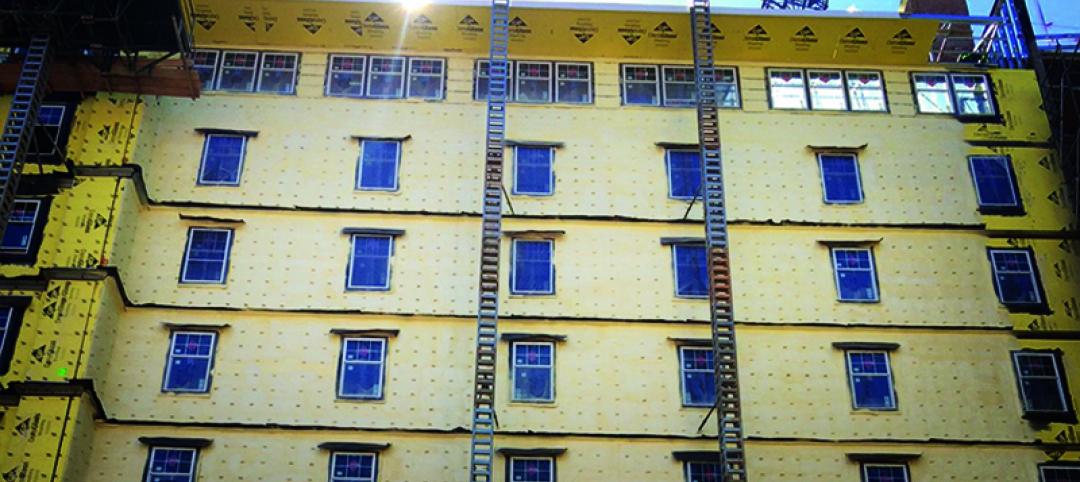Increases in energy costs are leading many building owners and facility managers to look for more cost-effective ways to heat and cool their buildings. Apartment buildings and student residences currently using electric systems are prime candidates for conversion to hydronic heating systems, and sometimes even water-based cooling systems.
Wilfred Laurier University, in Waterloo, Ont., opted to retrofit the electric heating systems in two of its existing student residences. The school went with hydronic heating and cooling for one of the buildings and hydronic heating for the other (which continues to use its existing forced-air DX cooling system).
The Bricker Residence, a nine-story apartment-style structure with four-bedroom suites that feature a common kitchen, bathroom and living room, required a retrofit that was designed to have fan coil units located in each of the suites, and a new piping system added to supply heating and cooling water in a two-pipe switch-over system.
The five-story Grand River Residence included classrooms and administrative offices on the first two floors with residence rooms on floors three through five. The project was designed to have hydronic reheat coils added to the existing VAV boxes already installed in the offices, classrooms and suites while the existing forced-air cooling system was kept intact. Due to the configuration of the building and the various locations of the VAV boxes, each floor had its own main loop that was fed with larger-diameter risers.

Tight timeframes and tight spaces
One of the key challenges was to have the installations completed when students were on summer break. Due to the tight timeline, and the fact that these were both existing finished buildings, mechanical contractor Modern Niagara opted to use PEX piping instead of a rigid pipe system. There were a number of areas where space was limited for the installation of pipe, so the flexible nature of Uponor PEX proved to be advantageous in those areas.
Uponor Design Services created the piping designs for each of the projects to ensure the pipe sizing and flow rates would meet with the engineer’s original design calculations and requirements. The project incorporated PEX sizes up to and including 3" diameter pipe with larger sizes being black iron.
For the Bricker Residence, Uponor PEX risers were installed between floors to connect to each of the fan coil units. The Grand River Residence utilized smaller-diameter Uponor PEX branched from the main loop on each floor to feed each of the reheat coils.
For both projects, the installers transitioned between black iron pipe and 3" PEX with brass threaded transitions and/or flange kits. Flange kits were also used for connecting the PEX pipe to some valves and circuit setters. Most of the horizontal PEX installations included Uponor PEX-a Pipe Support to allow for fewer hanging brackets and to help minimize pipe expansion.
Upon completion, the systems were filled and pressure tested, and the piping system was insulated before reinstalling the ceiling panels and sections of drywall. Thanks to the ingenuity of the system design and the efficiency of the installation crews, both projects were completed on schedule and the buildings were ready for the fall semester of incoming students.
Related Stories
Sponsored | Insulation | Jun 18, 2015
A modern approach to continuous insulation
The poject included replacing the original residence halls built in the 1970s
Sponsored | Transit Facilities | Jun 15, 2015
Success through teamwork for landmark California project
The Anaheim Regional Transportation Intermodal Center (ARTIC) is the Grand Central Station of the future
HVAC | Feb 6, 2015
ASHRAE, REHVA publish guide to chilled beam systems
The guide provides tools and advice for designing, commissioning, and operating chilled-beam systems.
Brick and Masonry | Feb 5, 2015
3D-printed 'cool brick' may provide cooling solution for arid locations
Cool Brick is made of porous ceramic bricks set in mortar. The bricks absorb water, which cools the air as it passes through the unit.
| Dec 28, 2014
New trends in ceiling designs and materials [AIA course]
A broad array of new and improved ceiling products offers designers everything from superior acoustics and closed-loop, recycled content to eased integration with lighting systems, HVAC diffusers, fire sprinkler heads, and other overhead problems. This course describes how Building Teams are exploring ways to go beyond the treatment of ceilings as white, monolithic planes.
| Sep 5, 2014
Uponor launches new stainless-steel manifold for radiant heating and cooling applications
Made of corrosion-resistant stainless steel, the manifold is available in 1" and 1¼" sizes in 2 through 8, 10 and 12 loop configurations.
| Aug 14, 2014
8 do's and don'ts for completing an HVAC life cycle cost assessment
There are many hurdles to overcome when completing a life cycle cost assessment. RMF Engineering’s Seth Spangler offers some words of advice regarding LCCAs.
| Aug 14, 2014
Life cycle cost analysis using energy modeling
A life cycle cost analysis helps a school district decide which HVAC system to use in $198 million worth of future building projects.
| Aug 4, 2014
Facebook’s prefab data center concept aims to slash construction time in half
Less than a year after opening its ultra-green, hydropowered data center facility in Luleå, Sweden, Facebook is back at it in Mother Svea with yet another novel approach to data center design.
| Jul 17, 2014
A harmful trade-off many U.S. green buildings make
The Urban Green Council addresses a concern that many "green" buildings in the U.S. have: poor insulation.

















